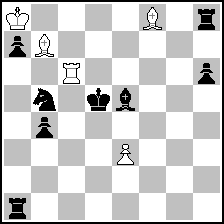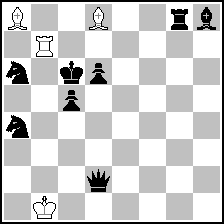|
|
| (1) Posted by Miodrag Mladenović [Wednesday, Jun 28, 2017 19:57] |
Borislav Gadjanski - The Problemist 2013 - 1st Prize
I just saw in the latest issue of "The Problemist" very nice 1st Prize winning problem by administrator of this site:
1 Pr The Problemist 2013
 (= 5+8 ) (= 5+8 )
H#2 2 solutions
i) 1.Sc7+ Kb8 2.Se6+ Rc7#
ii) 1.Sa3 Ka7: 2.Sc4+ Ra6#
Beautiful problem.
|
|
| (2) Posted by Miodrag Mladenović [Wednesday, Jun 28, 2017 20:17] |
It's very interesting how symmetry has been avoid. For example here is correct version with 9 pieces only:
(verssion)
 (= 4+5 ) (= 4+5 )
H#2 2 solutions
However Borislav's possition is much better because symmetry is broken.
|
|
| (3) Posted by seetharaman kalyan [Thursday, Jun 29, 2017 09:57] |
Nice version Misha highlighting the symmetric play of the original.
|
|
| (4) Posted by Harry Fougiaxis [Thursday, Jun 29, 2017 10:40] |
It reminds me the fantastic E053 of the recent WCCT-10, http://www.wfcc.ch/wp-content/uploads/WCCT10_ENTRIES_E.pdf
I wouldn't be surprised if Bora is the composer of E053 too...
|
|
| (5) Posted by Marjan Kovačević [Thursday, Jun 29, 2017 14:04] |
The economical version is not only symmetrical, it is more of a scheme than a problem.
It misses very important tries 1.Sd4?? and 1.Sd6?? that serve as a ground for the Black correction moves 1.Sc7!! and 1.Sa3!!
Next, this version misses White correction effects, reducing 2...Rc~? to 2...Rc7# and 2...Ra~? to 2...Ra6#
This combination of Black correction, White correction, and tempo strategy creates the whole atmosphere of the content.
So, instead of talking about better version, I would rather talk about comparison between straightforward execution and a real composition.
|
|
| (6) Posted by Miodrag Mladenović [Thursday, Jun 29, 2017 14:11] |
@Marjan, I completely agree with your comment. And I am glad that this discussion started. It's good for young composers to learn about what is good and what is wrong in chess problems. By the way I've got almost identical comment (through the note) by another composer who did not want to participate openly in this thread due to his personal reasons.
I wish there are more discussions like this one at this forum (with some nice problems) instead of endless discussions without some specific problems to look. I wish to see more problems and discussions about them. That's why I started this thread.
|
|
| (7) Posted by Steffen Slumstrup Nielsen [Thursday, Jun 29, 2017 14:53] |
I couldn't agree more. As an inexperience composer of helpmates I really treasure the rare occasions when discussions in this forum become concrete like here.
And too much symmetry is certainly a recurring theme in my feeble attempts at helpmates.
|
|
| (8) Posted by Nikola Predrag [Friday, Jun 30, 2017 05:42] |
The scheme offers interesting approaches, rich with tries where the same elements must be carefully combined to achieve useful effects but avoiding harmful line-effects caused by disability to lose/gain tempo.
Which checks are harmful and which irrelevant, could 1...Ba5 be used or missed as anticritical move or used as a tempo move with harmful critical effect or be lacking as a tempo move due to interference by bSs, which pieces should block the flights?
 (= 4+8 ) (= 4+8 )
h#2
1.Qe2? Ba5/Kc1 2.Qb5(+) Rc7#??
1.Rg7? tempo(Ba5?/Ka1?) 2.Rd7(+) Rb6#(Rb2+ 3.Rb7!)
1.Sc7? tempo(Ba5??) 2.Sb5 R7~#
1.Sb6? tempo(Ba5??) 2.Sd7 Rb~#
1.Sb8! Ba5 2.Sd7 Rb8#
1.Sc3+! Ka1 2.Sb5+ Rg7#
|
|
| (9) Posted by Darko Šaljić [Friday, Jun 30, 2017 09:15] |
This "Administrators" :) wonderful problem also includes a battery combination
which could be recognized as black Siers?
|
|
| (10) Posted by Darko Šaljić [Saturday, Jul 1, 2017 11:44] |
Please continue with the discussion, excuse me on my post and ignore it, I forgot that I was not welcome after the previous appearances. I will disappear completely, and as a reader, I promise.
|
|
| (11) Posted by seetharaman kalyan [Sunday, Jul 2, 2017 19:25]; edited by seetharaman kalyan [17-07-02] |
Black Siers... ! Interesting name. I suppose many Wcct 10 entries will qualify
|
|
| (12) Posted by Juraj Lörinc [Sunday, Jul 2, 2017 21:23] |
If "black Siers" is a suggested name for knight manoeuvre shown in the prized h#2 in the very first post, I'd say it is quite unfortunate suggestion for at least two reasons:
- the manoeuvre does not involve provision of a flight to (white) King by means of direct unguarding in the battery check move - this is an essential part of standard Siers
- naming of themes by composers without any technical connection / descriptive quality is actually making chaos in minds of many (in each genre there are tons of obscurely-named themes known only to specialists).
|
|
| (13) Posted by Darko Šaljić [Monday, Jul 3, 2017 07:18] |
It was not a proposal, but only a visual perception with a question mark.
|
|
| (14) Posted by seetharaman kalyan [Monday, Jul 3, 2017 12:20] |
You are right Juraj about this problem. But many Wcct-10 entries indeed provide flight to to the white king by a check and following up with a another move if the checking piece.
|
|
| (15) Posted by Darko Šaljić [Monday, Jul 3, 2017 16:25]; edited by Darko Šaljić [17-07-03] |
A man who don't uderstand a context in wich someone wrote a comment, but only follow his vanity and claim himself as a chess problem policeman, could never be right.
|
|
| (16) Posted by Frank Richter [Wednesday, Jul 12, 2017 18:15] |
Provisional award 10. WCCT, section E:
1st place – E053 – Ofer Comay, Israel – 10.2 points.
Congratulations!
|
|
No more posts |
MatPlus.Net  Forum Forum  Helpmates Helpmates  Borislav Gadjanski - The Problemist 2013 - 1st Prize Borislav Gadjanski - The Problemist 2013 - 1st Prize |
 ISC 2024
ISC 2024 Forum
Forum  Helpmates
Helpmates  Borislav Gadjanski - The Problemist 2013 - 1st Prize
Borislav Gadjanski - The Problemist 2013 - 1st Prize 


